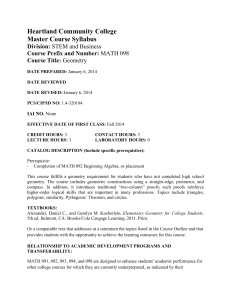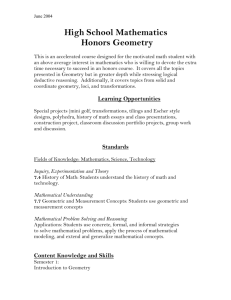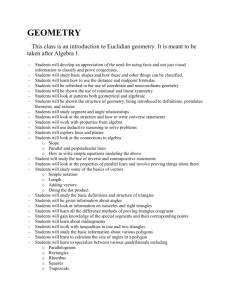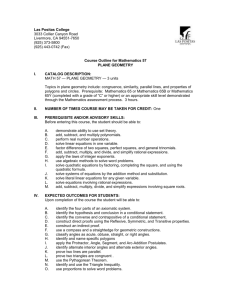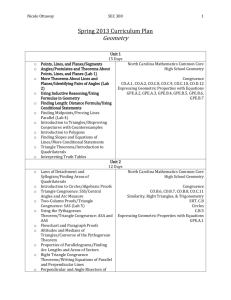Course Syllabus
advertisement
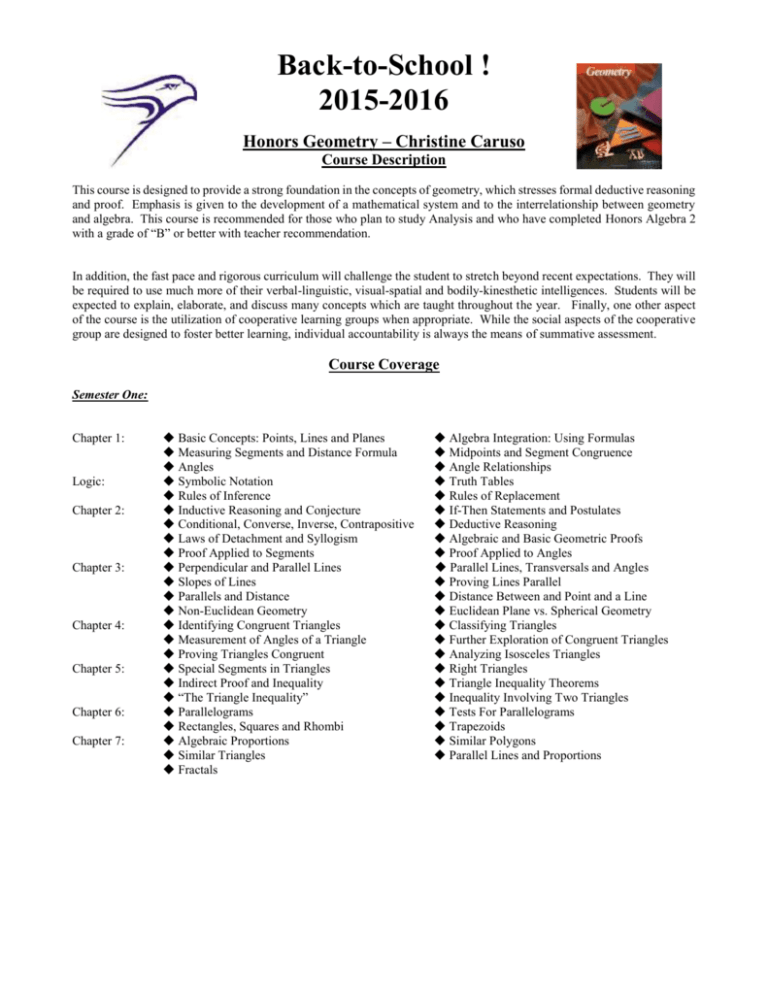
Back-to-School ! 2015-2016 Honors Geometry – Christine Caruso Course Description This course is designed to provide a strong foundation in the concepts of geometry, which stresses formal deductive reasoning and proof. Emphasis is given to the development of a mathematical system and to the interrelationship between geometry and algebra. This course is recommended for those who plan to study Analysis and who have completed Honors Algebra 2 with a grade of “B” or better with teacher recommendation. In addition, the fast pace and rigorous curriculum will challenge the student to stretch beyond recent expectations. They will be required to use much more of their verbal-linguistic, visual-spatial and bodily-kinesthetic intelligences. Students will be expected to explain, elaborate, and discuss many concepts which are taught throughout the year. Finally, one other aspect of the course is the utilization of cooperative learning groups when appropriate. While the social aspects of the cooperative group are designed to foster better learning, individual accountability is always the means of summative assessment. Course Coverage Semester One: Chapter 1: Logic: Chapter 2: Chapter 3: Chapter 4: Chapter 5: Chapter 6: Chapter 7: Basic Concepts: Points, Lines and Planes Measuring Segments and Distance Formula Angles Symbolic Notation Rules of Inference Inductive Reasoning and Conjecture Conditional, Converse, Inverse, Contrapositive Laws of Detachment and Syllogism Proof Applied to Segments Perpendicular and Parallel Lines Slopes of Lines Parallels and Distance Non-Euclidean Geometry Identifying Congruent Triangles Measurement of Angles of a Triangle Proving Triangles Congruent Special Segments in Triangles Indirect Proof and Inequality “The Triangle Inequality” Parallelograms Rectangles, Squares and Rhombi Algebraic Proportions Similar Triangles Fractals Algebra Integration: Using Formulas Midpoints and Segment Congruence Angle Relationships Truth Tables Rules of Replacement If-Then Statements and Postulates Deductive Reasoning Algebraic and Basic Geometric Proofs Proof Applied to Angles Parallel Lines, Transversals and Angles Proving Lines Parallel Distance Between and Point and a Line Euclidean Plane vs. Spherical Geometry Classifying Triangles Further Exploration of Congruent Triangles Analyzing Isosceles Triangles Right Triangles Triangle Inequality Theorems Inequality Involving Two Triangles Tests For Parallelograms Trapezoids Similar Polygons Parallel Lines and Proportions Semester Two: Geometric Means 45-45-90 and 30-60-90 Triangles Angles of Elevation and Depression Basic Circle Terminology Arcs and Chords of Circles Tangents to Circles and Theorems Special Segment Lengths of Circles Chapter 10: Constructions Concurrent lines Locus Chapter 11: Area of polygons Area of regular polygons Arc length and Area of sectors Chapter 12: Area of Solid figures Spheres Non-Euclidean: Alternative Deductive Systems Riemannian/Elliptical Models Chapter 13: Coordinate Geometry Linear equations Chapter 14: Mappings Reflections, Translations, Rotations, Dilations Chapter 8: Chapter 9: The Pythagorean Theorem Trigonometric Ratios Laws of Sines and Cosines Angles and Arcs of Circles Inscribed Angles Secants, Tangents and Angles Measures Algebraic Equation of a Circle Perpendicular/Parallel construction Circle Construction Locus and constructions Rect, Parallelogram,triangles trapezoids,Rhombus Circumference, area of circles Geometric Probability Prisims,Pyramids,cylinders,cones Area and volume similar solids Lobachevskian/Hyperbolic Models Distance, slope, parallel, perpendicular, midpoint Coordinate Proof Additional Projects In addition to the curriculum outlined above, there are a few other supplementary projects incorporated into the course. Research Project: The student will be completing a research project during the year. The presentation will be done in class with a partner. The student will research an assigned topic (hopefully of their choice); form a relevant bibliography; prepare note cards; Prepare a formal lesson plan and present the topic to the class. Although the presentations will occur in pairs, each student will be assigned a separate grade. Flatland: During the year each student will read the short novel Flatland, and prepare a written analysis of the concepts addressed. The novella is intended to inspire thought and interpretation which extends beyond the mathematical. Constructions: Student will be doing formal constructions in class, using a compass and straight edge. Several construction packets will be given out and collected. Precision is critical when performing Geometric constructions. These constructions expand upon and solidify major concepts taught throughout the year. Homework Expectations Homework is an integral part of the course. It is especially important for the Honors student to develop and accept a college level responsibility that this course simulates, as he/she will not typically have homework collected, graded or included as part of their grade at college. Homework will be checked periodically, and it will count as 5% of the marking period grade. Effort is made to minimize homework assignments to the key problems for each section. While it is not checked every day, it is expected that each student will do at least the minimum number of problems that will still cover all of the important topics of that day's lesson. Some problems are intentionally omitted for those students wanting and/or needing some extra review. On rare days when there may be no assignment, it is still a good idea to look ahead at the material coming up or take time to review a topic that caused difficulties in the past. Extra Practice sheets are also assigned regularly at the culmination of a large unit. Testing and Grading All quizzes and tests will be available to students to take home once all students have taken the assessment. You can view the full district assessment return policy on my website. Testing: There will be at least one major test per chapter and it will usually count 100 points. Quizzes can be either announced or unannounced and will vary in points from 10 through 40. Additionally; periodic homework assignments will be given and will count as take-home quizzes. Homework grades will usually count 10-40 points. With the exception of the Geometry Mid-Term and Final Exam, all evaluations will be returned to the student. Grading:. Grading is done on a points system and the district scale can be viewed in more depth on my website. The following general scale will establish the letter grade: 90 - 100 A 80 - 89 B 70 - 79 C 60 - 69 D 0 - 59 F (A plus sign indicates a grade within 2 percentage points of the next higher letter grade, while a minus sign indicates a grade within 2 percentage points of the next lower grade) Missing test and quiz scores are counted as zeros unless other arrangements have been made. Please check your son's/daughter's student handbook for information pertaining to frequent absences, cutting class, student activity trips, interim report dates, report card dates, and extended absence from school. I also recommend regularly checking the Home Access Center to monitor grades. Any need that a student has to discuss their performance should be done by appointment after school, as discussions of grades before or after class can be quite a disruption to the lesson. Classroom Etiquette Be prompt: Students should be in the classroom before the tardy bell rings. If you need to sharpen pencils and/or secure bathroom privileges, please do so at the beginning of the class period. Be considerate: Don't speak while the teacher or another student is speaking. Raise your hand and wait to be recognized. Food and drink are not to be consumed during class. Be involved: While no student is ever penalized for being shy, active involvement in the daily lesson is a must. Enthusiastic pursuit of the beauty and truth contained within mathematics is encouraged and greatly appreciated. After-school clinic Clinic is on Tuesday and Thursday until 3pm. Other days are available upon request. I am available nearly all the time, and enjoy working with eager students wanting to improve themselves. With that extra help comes certain responsibilities and expectations. It is extra help and in no way replaces the regular classroom instruction. In situations where work has been missed, it is the student's responsibility to get the missing notes and assignments from one of his/her classmates. Each student should then read the assignment(s) and attempt each of the problems. After doing the preceding, make an appointment for clinic. Do not expect to use after-school clinic as a tutoring session to make up lost time due to vacations, field trips, or other absences which are not related to illness. However, I am willing to do whatever it takes to assist the student in achieving whatever his/her goal may be. Miscellaneous You can find information about class on my web site, including weekly homework assignments that are usually posted by the end of the day Monday. Please be aware that I do not update this web site everyday. My web site is constantly “under construction”. I will do my best to keep it up to date, but I am not always able to do this. Thank you for your understanding. Students should check the Home Access Center regularly to monitor their progress in the class. If you have any questions about your son's/daughter's assignments or classroom progress, please feel free to contact me at Work: 215-944-1153. E-MAIL: CCARUSO@CRSD.org Respectfully, Christine Caruso This isn’t math … where are the numbers? Proofs … Proofs and … Proofs THE WHOLE BOOK … and then some!!! Constructions All those THEOREMS!!! Logic and Philosophy Flatland Why is HONORS GEOMETRY such a challenge? Vocabulary Proofs … Proofs … Proofs Visualizing and Drawing Presentation Individual Responsibility The Pace and Rigor Right Brain Stimulation
